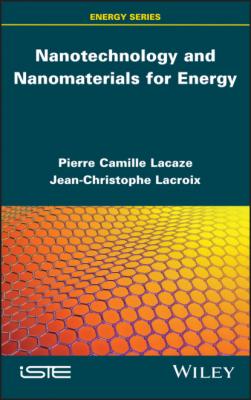Nanotechnology and Nanomaterials for Energy. Pierre-Camille Lacaze
Читать онлайн.| Название | Nanotechnology and Nanomaterials for Energy |
|---|---|
| Автор произведения | Pierre-Camille Lacaze |
| Жанр | Физика |
| Серия | |
| Издательство | Физика |
| Год выпуска | 0 |
| isbn | 9781119881575 |
303 299
304 300
305 301
306 302
307 303
308 304
309 305
310 306
311 307
312 308
313 309
314 310
315 311
316 313
317 314
318 315
319 317
320 318
321 319
322 320
323 321
324 322
325 323
326 324
327 325
328 326
329 327
330 328
331 329
332 330
333 331
334 332
335 333
336 334
337 335
338 336
339 337
340 338
341 339
342 340
343 341
344 342
345 343
346 344
347 345
348 346
349 347
350 348
351 349
352 350
353 351
354 352
355 353
356 354
357 355
358 356
359 357
360 358
361 359
362 360
363 361
364 363
365 364
366 365
367 366
368 367
Series EditorPierre-Noël Favennec
Nanotechnology and Nanomaterials for Energy
Pierre Camille Lacaze
Jean-Christophe Lacroix
First published 2021 in Great Britain and the United States by ISTE Ltd and John Wiley & Sons, Inc.
Apart from any fair dealing for the purposes of research or private study, or criticism or review, as permitted under the Copyright, Designs and Patents Act 1988, this publication may only be reproduced, stored or transmitted, in any form or by any means, with the prior permission in writing of the publishers, or in the case of reprographic reproduction in accordance with the terms and licenses issued by the CLA. Enquiries concerning reproduction outside these terms should be sent to the publishers at the undermentioned address:
ISTE Ltd
27-37 St George’s Road
London SW19 4EU
UK
John Wiley & Sons, Inc.
111 River Street
Hoboken, NJ 07030
USA
© ISTE Ltd 2021
The rights of Pierre Camille Lacaze and Jean-Christophe Lacroix to be identified as the authors of this work have been asserted by them in accordance with the Copyright, Designs and Patents Act 1988.
Library of Congress Control Number: 2021941647
British Library Cataloguing-in-Publication Data
A CIP record for this book is available from the British Library
ISBN 978-1-78630-497-1
Introduction
The term “nanomaterials”, by general consensus, is used to designate both nano-objects and nanostructured materials. To qualify as a nanomaterial, the dimensions of an object or of a structural element of a macroscopic material must be less than about one hundred nanometers. In addition to this first, generic definition, a distinction is made between zero-dimensional nanoparticles (0D-NP); nanowires (NW) and nanotubes (NT), which are one-dimensional (1D-NP); nanosheets and multi-sheets, which are two-dimensional (2D-NP); and, finally, three-dimensional (3D) nanostructured materials. Further distinctions are made between these forms based on their material composition: carbonaceous, inorganic or hybrid.
I.1. History of nanotechnology
Nanotechnologies first came into public view in the year 2000. This was the year the National Nanotechnology Initiative1, or NNI, was launched in the United States, propelled by the NSF (National Science Foundation), a large number of academic societies and multiple federal departments. The new and innovative properties of nanomaterials discovered over the course of the 1980s and 1990s opened a vast range of perspectives in terms of applications, attracting the attention of researchers and industrialists, who began to devote considerable time and attention to exploiting these new opportunities. These initiatives attracted almost unprecedented support from public authorities, and President Clinton, visiting Caltech in January 2000, specifically designated this initiative as a national developmental priority. Different fields of application were defined in collaboration with several government agencies, who also provided funding; this new area of research was seen as a likely source of significant scientific progress with the potential to benefit the whole of society.
Why, then, did nanotechnology attract such levels of attention from the US government in the early 2000s? Without going into too much detail, it is important to note that the 1980s and 1990s were marked by a number of important scientific discoveries relating to extremely small elements; this went hand-in-hand with technological developments which greatly increased the capacity to observe the state and performances of materials.
Transmission electron microscopy (TEM) was first commercialized by Siemens and Ernst Ruska2 and continued to develop over the following decades. By the 1990s,
